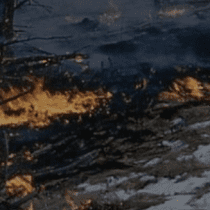Research and Publications
In the Western U.S., the 2020 fire season is setting new records in terms of geographic scale, fire intensity, and rates of spread. Tens of millions of people are currently being forced to breathe beneath a dense layer of smoke, as others have lost their lives and property.
With each new record-setting fire, the same question comes up again and again: is this due to climate change, or is this due to forest mismanagement? After dueling appearances on Monday, this question now appears to be a matter of debate in the Presidential campaign.
The climate change vs. management question ignores nuance that is crucial for finding scientific answers and policy solutions. The factors influencing wildfire behavior are complex, and the dominant drivers vary between different locations and events. Below are five key things to know about the causes of the current wildfire problem. Understanding them can help us navigate the question of what is driving increased fire activity and what can be done to reduce such large fires in the future.
View article.
The hundreds of Indigenous tribes in the United States harbor diverse perspectives about the natural world, yet they share many views that are important for ecosystem restoration efforts. This paper features examples of how such views have guided ecosystem restoration through partnerships between tribal communities and the U.S. Forest Service in the western United States. Traditional perspectives have influenced restoration by deepening the understanding of reference conditions, expanding consideration of system dynamics, and guiding treatment based upon ethical principles and beliefs. More holistic perspectives may enhance restoration success by encouraging positive psychological and social effects that help sustain community efforts. Guided by traditional perspectives, restoration activities can reveal evidence of past human engagement with the land, which further illustrates the need and opportunity for restoration. Traditional perspectives can encourage more integrative, ethical, and self-reinforcing restoration that will benefit present-day tribal and non-tribal communities.
View synthesis.
Frequent-fire forests of the western United States have undergone remarkable changes in structure, composition, and function due to historical exclusion of naturally occurring fire. Mechanized tree thinning to reduce forest density and fuel loads tends to be expensive and cannot be effectively implemented across all lands, and there is increasing interest in managing naturally ignited wildfires for meeting forest restoration objectives. To investigate general effectiveness of resource objective (RO) wildfires for restoring frequent-fire and associated forests of the western United States, a review of the related peer-reviewed literature was conducted.
View article.
The increasing complexity of wildland fire management highlights the importance of sound decision making. Numerous fire management decision support systems (FMDSS) are designed to enhance science and technology delivery or assist fire managers with decision-making tasks. However, few scientific efforts have explored the adoption and use of FMDSS by fire managers. This research couples existing decision support system research and in-depth interviews with US Forest Service fire managers to explore perspectives surrounding the Wildland Fire Decision Support System (WFDSS). Results indicate that fire managers appreciate many WFDSS components but view it primarily as a means to document fire management decisions. They describe on-the-ground actions that can be disconnected with decisions developed in WFDSS, which they attribute to the timeliness of WFDSS outputs, the complexity of the WFDSS design, and how it was introduced to managers. We conclude by discussing how FMDSS development could address concerns raised by managers.
View brief.
Indaziflam (Rejuvra®, Bayer) is a pre-emergent herbicide that can manage annual grass seed banks and provide long-term reductions with minimal harm to established perennial vegetation. Indaziflam provided significant, long-term reductions in cheatgrass cover and density in invaded sagebrush-grasslands in western Wyoming without negative effects on native vegetation species richness. Observations from the site after an unplanned wildfire suggest that treatment three years earlier may have prevented the fire from burning significant areas of two large aerial treatment plots, likely by reducing the amount and continuity of fine fuel. These results suggest that indaziflam may help managers mitigate the impacts of invasion and proactively protect intact shrublands from cheatgrass-altered fire regimes.
View the synthesis.
Exotic grasses are a widespread set of invasive species that are notable for their ability to significantly alter key aspects of ecosystem function. Understanding the role and importance of these invaders in forested landscapes has been limited but is now rising, as grasses from Eurasia and Africa continue to spread through ecosystems of the Americas, Australia, and many Pacific islands, where they threaten biodiversity and alter various aspects of the fire regime. The ecological, social and economic impacts of the grass-fire cycle associated with species such as cheatgrass (Bromus tectorum) have been long recognized in aridlands such as the iconic sagebrush ecosystems of the western US. However, the damaging impacts of invasive grasses in forestlands have received considerably less attention. We review literature, conceptual models, model output, and empirical evidence that indicate grass invasion in forest ecosystems may be an important yet largely under-recognized phenomenon. In combination with climate change, wildfire, and overstory management, invasive grasses could create a “perfect storm” that threatens forest resilience. Invasive grasses can be successful in forested environments or develop strongholds within forested mosaics and could provide the literal seeds for rapid change and vegetation type conversion catalyzed by wildfire or changes in climate. Although invasive grass populations may now be on the edge of forests or consist of relatively rare populations with limited spatial extent, these species may disrupt stabilizing feedbacks and disturbance regimes if a grass-fire cycle takes hold, forcing large portions of forests into alternative nonforested states. In addition, forest management actions such as thinning, prescribed fire, and fuel reduction may actually exacerbate invasive grass populations and increase the potential for further invasion, as well as broader landscape level changes through increased fire spread and frequency. Lack of understanding regarding the ecological consequences and importance of managing invasive grasses as a fuel may lead to unintended consequences and outcomes as we enter an age of novel and rapid ecological changes. This paper focuses on the contributory factors, mechanisms, and interactions that may set the stage for unexpected forest change and loss, in an effort to raise awareness about the potential damaging impact of grass invasion in forested ecosystems.
View the brief.
Sagebrush ecosystems in the northern Great Basin face threats from invasive annual grasses and expanding conifers. Land managers need to work at large spatial scales to address these two ecological threats, but have limited resources to do so. This guide provides a framework for land managers to efficiently identify, discuss and address landscape-level threats. It is not an
instruction manual.
View the document.
The toolkit is comprised of three elements:
- A roadmap for invasive grass management in the West, with new best management practices for the identification, protection, and expansion of “core” areas – regions with relatively low, or no, annual grass invasion;
- Case studies highlighting the application of these practices in Idaho and Wyoming; and
- A new geospatial data layer (which uses analytical tools to compile existing federal data) to help state and local managers assess invasive annual grasses within their jurisdictions, while also offering opportunities to identify new cross-boundary collaborative projects.
View brief.
Land managers face a mounting variety of challenges, including how to efficiently dispose of excessive woody residues on forest sites (especially in the Western United States), maintain and improve soil productivity, improve forest resilience to changes in climate (especially as it pertains to drought and fire), and increase the effectiveness of reforestation activities. The use of biochar, a charcoal that is not readily degraded and is made specifically for land application, may have a role in meeting these challenges. Moreover, biochar may provide nursery managers with opportunities to produce seedlings for reforestation and restoration in a more sustainable way, particularly by reducing irrigation inputs, as evidenced through several trials summarized here.
View article.
Drylands encompass over 40% of terrestrial ecosystems and face significant anthropogenic degradation causing a loss of ecosystem integrity, services, and deterioration of social‐ecological systems. To combat this degradation, some dryland restoration efforts have focused on the use of biological soil crusts (biocrusts): complex communities of cyanobacteria, algae, lichens, bryophytes, and other organisms living in association with the top millimeters of soil. Biocrusts are common in many ecosystems and especially drylands. They perform a suite of ecosystem functions: stabilizing soil surfaces to prevent erosion, contributing carbon through photosynthesis, fixing nitrogen, and mediating the hydrological cycle in drylands. Biocrusts have emerged as a potential tool in restoration; developing methods to implement effective biocrust restoration has the potential to return many ecosystem functions and services. Although culture‐based approaches have allowed researchers to learn about the biology, physiology, and cultivation of biocrusts, transferring this knowledge to field implementation has been more challenging. A large amount of research has amassed to improve our understanding of biocrust restoration, leaving us at an opportune time to learn from one another and to join approaches for maximum efficacy.





